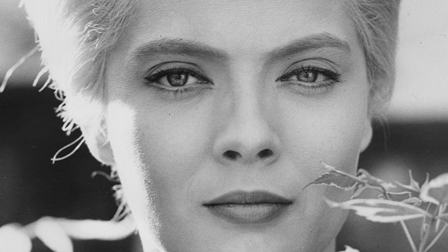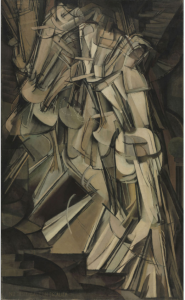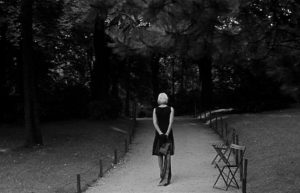Screening Monday October 24 at 7pm

Cléo from 5 to 7, by Left Bank filmmaker and decidedly feminist voice Agnés Varda, tells the story of a spoiled pop singer, Cléo as she suddenly confronts a cancer diagnosis and the possibility of death. The film begins with a superstitious Cléo’s visit to a fortuneteller, who confirms the possibility of her looming finality. Leaving the apartment, we see Cléo through a series of jump cuts that fragment her decline down a staircase, a physical representation of her own, sudden existential crisis. Critic Molly Haskell suggests Varda’s allusion here to Nude Descending a Staircase (Marcel Duchamp, 1912), in both the painting and film’s portrait of an intimate, internal subjectivity.
suddenly confronts a cancer diagnosis and the possibility of death. The film begins with a superstitious Cléo’s visit to a fortuneteller, who confirms the possibility of her looming finality. Leaving the apartment, we see Cléo through a series of jump cuts that fragment her decline down a staircase, a physical representation of her own, sudden existential crisis. Critic Molly Haskell suggests Varda’s allusion here to Nude Descending a Staircase (Marcel Duchamp, 1912), in both the painting and film’s portrait of an intimate, internal subjectivity.
https://www.youtube.com/watch?v=jqNw-zaM6r4
We continue to follow Cléo’s Parisian wanderings – as she goes to a café, buys a winter hat (though the story takes place in the summertime), takes a taxi ride, and briefly meets at home with her lover and then two musician friends. In all her actions, we see a disorientation and apparent self-consciousness, created through Varda’s employment of cinécriture, or writing on film. As passersby seem to gaze towards Cléo, their conversations becoming audible and their gaze absorbing the screen, Varda demonstrates Cléo’s female consciousness as being shaped by a need for outside gratification rather than internal wants — the protagonist herself articulating “I’m always free when he wants me.”
Varda brings to Cléo from 5 to 7 her background as a photographer and documentarian, juxtaposing filmic images against the intrusion of topical daily news. The Algerian War meddles most prominently, drawing relations between Algeria’s drive for national self-determination and female confinement. In the final scenes of the film, Cléo’s encounter with a soldier on leave from the war, who doesn’t know her or her music, allows her to enter into a more human, less constrained relationship, one beyond her own self-regard. Both escaping a sort of “war” of captivity, Cléo and her new companion Antoine find solace in their mutual incertitude.
It would be impossible to watch Cléo from 5 to 7 without immediate recognition of the spatial and temporal themes of its narrative – concerns that arise in its title even before the film begins. While Cléo’s actions are mundane, her day made up of errands and visits to friends, her transformation over two hours is deeply emotional – an intelligent articulation of mortality. Every cut accumulates with anxiety, associating an immediacy and tension about her diagnosis, her status as female, and the state of the tumultuous 1960s world. The viewer sees, in timely precision, not only Cléo’s real world surroundings, but also her internal perception of them – through the eyes of a woman.
To make the weight of time even clearer, at one point the narrative launches into a film within a film, starring two of French New Wave’s most recognizable faces – Anna Karina and Jean-Luc Godard. The internal comedy articulates the presence of duration candidly with its rolling film reel and quickening music. It’s conscious of its own cinematic existence and thus the fact of limited duration.
Launching back into Cléo’s narrative, every cut accumulates with anxiety, associating an immediacy and tension with her diagnosis, her status as female, and the state of the world. The viewer sees, in timely precision, not only Cléo’s real world surroundings, but also her internal perception of them – through the eyes of a woman.
Cléo struggles simultaneously against her own self-regard and other’s objectification of her beauty. Yet Varda doesn’t seem to blame Cléo for her vanity. Rather, the camera’s gaze interrogates our own fascination with beauty, and more broadly with women as objects, rather than individuals. Varda’s own preoccupation with mirrors, silence, and disorienting edits portray how women see and are seen by their world – with an acute self-awareness.
The limited frame of filmic space and time mimics Cléo’s own confinement through her limited sense of self, articulated through an early line, “As long as I’m beautiful, I’m alive.” But by the film’s conclusion any sense of containment is diminished, suggesting the possibility for an un-gendered experience of the world and ultimately presenting each moment as the infinite present. Ideas of mortality are met with the recognition of the simultaneous cosmic meaningless of our earthly experience and the vibrancy of the moment.
Sources: https://www.criterion.com/current/posts/87-cleo-from-5-to-7
Staci Dubow (2018) is majoring in History and Film/Media Studies. She is a writer and editor for the on campus publications Campus Vinyl and ETC Magazine – platforms through which she can explore her interest in art’s capacity, both historically and contemporarily, for social consciousness and consequently social and political change. She is also involved on campus in Speak UP Bucknell and teaches yoga at Bucknell and in the Lewisburg community.
